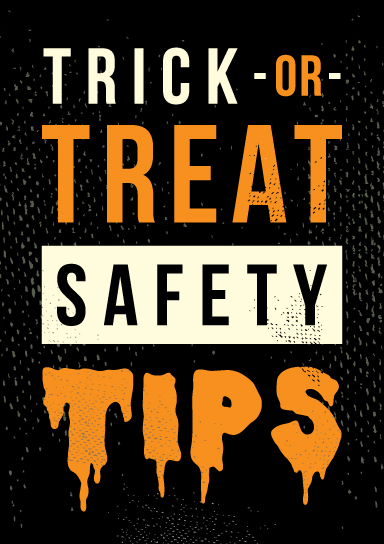 From goblins and ghouls to games and giggles, Halloween traditions offer plenty of fun and excitement. While the trick-or-treating provides kids with the much-anticipated opportunity to dress up and collect buckets of candy, the practice is not without its safety concerns. Increased pedestrian traffic, unfamiliar clothing and fading light can all combine to create less-than-ideal conditions as your little ones race door to door. Read on for a few Halloween safety tips, intended to get you thinking of ways to protect your trick-or-treaters from a holiday mishap.
From goblins and ghouls to games and giggles, Halloween traditions offer plenty of fun and excitement. While the trick-or-treating provides kids with the much-anticipated opportunity to dress up and collect buckets of candy, the practice is not without its safety concerns. Increased pedestrian traffic, unfamiliar clothing and fading light can all combine to create less-than-ideal conditions as your little ones race door to door. Read on for a few Halloween safety tips, intended to get you thinking of ways to protect your trick-or-treaters from a holiday mishap.
Costume safety
- Make sure all props and accessories, like swords and wands, are soft and flexible so they don’t cause injury if fallen on.
- Check costumes to ensure that shoes fit properly and hems don’t drag so as to prevent tripping hazards.
- Test all makeups and face paints on a patch of skin before applying to faces in case of rash or irritation.
- Avoid decorative contact lenses and false eyelashes to minimize the risk of eye irritation or infection.
- Use only fabrics that are clearly labeled flame resistant.
- Whether it’s sweltering or snowing, make sure kids are dressed appropriately for the weather.
Street safety
- Decorate costumes and treat bags with reflective tape to increase visibility.
- Encourage trick-or-treaters to carry a flashlight, which helps them see others and others see them.
- Remind kids to cross only at designated crosswalks, and to walk rather than run across streets.
- Make sure you or another trusted adult accompanies younger children. For older trick-or-treaters venturing out without a chaperone, map out an expected route so you can find them if necessary.
- Explain that children should only approach lighted houses in order to avoid hidden obstacles and respect those who do not want to participate in the trick-or-treating.
- Enhance neighborhood safety by making sure your own home is well lit and paths are clear of branches or debris that may cause trick-or-treaters to trip and fall.
Treat safety
- Serve a healthy dinner before trick-or-treating to reduce the temptation to snack on treats along the way.
- Insist that children bring home all treats to be inspected by a responsible adult, and discard anything not in original packaging or that looks tampered with.
- Remove choking hazards for younger children—including gum, hard candy and small toys.
- Limit the amount of sweets eaten the night of Halloween, and explain to kids that too much candy can make them feel sick and lethargic.
- Follow up by ensuring that kids eat only a few pieces of candy per day, and consider sharing excess with friends or turning it into candy crafts. Some dentists even offer candy exchange programs that reward children with prizes when they bring in their left-over treats.
Keep following us for more holiday tips and other homeowner resources!



